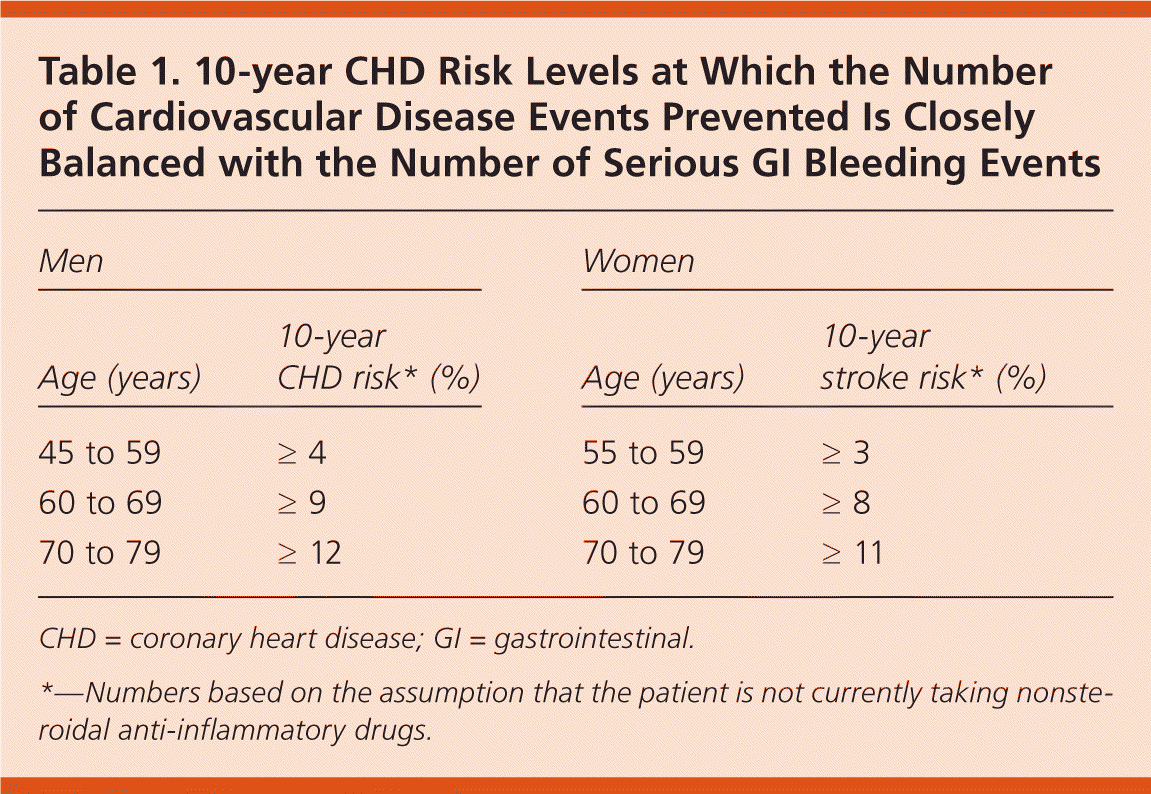
Am Fam Physician. 2011;83(12):1469-1470
Related U.S. Preventive Services Task Force Recommendation Statement.
Related editorials: Appropriate Aspirin Use for Primary Prevention of Cardiovascular Disease and The Case Against Routine Aspirin Use for Primary Prevention in Low-Risk Adults
Case Study
K.T., a 48-year-old man, presents for a routine office visit. He is worried about cardiovascular disease (CVD) and asks whether he should take daily aspirin to lower his risk. His blood pressure is 120/60 mm Hg, and his total cholesterol is 180 mg per dL (4.66 mmol per L), with a low-density lipoprotein level of 80 mg per dL (2.07 mmol per L) and a high-density lipoprotein level of 40 (1.04 mmol per L). He does not have diabetes mellitus and does not use tobacco. K.T. reports no gastrointestinal (GI) tract pain and says he has never had an ulcer or used anticoagulants. He estimates that he uses an over-the-counter nonsteroidal anti-inflammatory drug (NSAID) about twice per month for headache or joint pain. Based on this information, you calculate his risk of heart attack and GI hemorrhage, and determine that his risks of each are approximately the same.
Case Study Questions
Based on the recommendation from the U.S. Preventive Services Task Force (USPSTF), which one of the following is the appropriate next step regarding aspirin use for K.T.?
A. Recommend that he start an aspirin regimen to reduce his risk of myocardial infarction (MI).
B. Encourage aspirin use because he is older than 45 years.
C. Discourage aspirin use because he is younger than 50 years.
D. Encourage aspirin use to reduce the risk of ischemic stroke.
E. Discuss the risk factors for MI and GI hemorrhage, and elicit his preferences.
If K.T. were a woman and all other factors described above were the same, which one of the following would be the appropriate next step regarding aspirin use?
A. Discuss the risk factors for MI and GI hemorrhage, and elicit her preferences.
B. Discuss the risk factors for ischemic stroke and GI hemorrhage, and elicit her preferences.
C. Advise her that she does not need to consider daily aspirin use to reduce her risk of ischemic stroke before she reaches 55 years of age.
D. Encourage aspirin use to prevent ischemic stroke.
Which one of the following statements about aspirin use and CVD is correct?
A. CVD, including heart attack and stroke, is the second leading cause of death in the United States.
B. The optimal dosage of aspirin for preventing CVD is 75 mg per day.
C. The optimal dosage of aspirin for preventing CVD is not known, but 75 mg per day seems as effective as a higher dosage.
D. NSAID therapy combined with aspirin use neither increases nor decreases the risk of serious GI bleeding.
E. The USPSTF recommends against the use of aspirin for CVD prevention in men and women 80 years and older.
Answers
1. The correct answer is E. Discuss the risk factors for MI and GI hemorrhage with K.T., and elicit his preferences. The USPSTF recommends the use of aspirin in men 45 to 79 years of age when the potential benefit of a reduction in MIs outweighs the potential harm of an increase in GI hemorrhage. When benefits and harms are closely balanced, the physician should guide a shared decision-making process that explains the potential benefits and harms of using aspirin. The patient can then make an informed decision that incorporates his personal preferences and values. Web-based calculators that estimate 10-year risk of coronary heart disease (CHD) are available at http://hp2010.nhlbihin.net/atpiii/calculator.asp for men and http://www.westernstroke.org/PersonalStrokeRisk1.xls for women. Given his risk level and age, K.T. has a 10-year CHD risk of 4 percent (Table 1).

2. The correct answer is C. The USPSTF recommends against the use of aspirin for stroke prevention in women younger than 55 years. The USPSTF recommends that women 55 to 79 years of age use aspirin when the potential benefit of a reduction in ischemic strokes outweighs the potential harm of an increase in GI hemorrhage. Risk assessment for CVD in women differs from that in men. Age, diabetes, blood pressure, and smoking status must be considered in both sexes. Risks of MI in men also include high cholesterol; risks for ischemic stroke in women include a history of CVD, atrial fibrillation, and left ventricular hypertrophy.
3. The correct answer is C. The optimal dosage of aspirin for preventing CVD is not known, but a dosage of 75 mg per day seems to be as effective as a higher dosage. The risk of GI bleeding may increase with a dosage above 75 mg per day, with no apparent corresponding benefit in primary prevention of CVD. The USPSTF did not find sufficient evidence to determine the balance of benefits and harms for the use of aspirin to prevent cardiovascular events in men and women 80 years and older. Therefore, the USPSTF does not recommend for or against its use. NSAID therapy combined with aspirin use quadruples the risk of serious GI bleeding.
CVD, including heart attack and stroke, is the leading cause of death in the United States.
